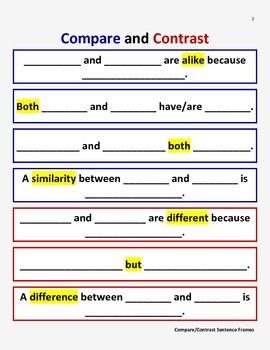In the dynamic realm of education, particularly within the teaching of writing, the use of structured frameworks can significantly enhance student comprehension and skill development. One such pivotal framework is the “compare and contrast sentence frame.” This tool serves as an essential bridge between rudimentary understanding and the complexities of analytical writing, facilitating a deeper exploration of ideas by laying out clear parameters for comparison.
At its core, the concept of comparison is intrinsic to human cognition. From an early age, individuals are taught to differentiate between various concepts, objects, and experiences. This basic cognitive process transitions seamlessly into more sophisticated applications in writing. The act of comparing and contrasting is not merely an academic exercise; it’s a pervasive intellectual activity that encourages critical thinking and the synthesis of ideas. Through this lens, the pedagogical significance of compare and contrast sentence frames becomes palpably clear.
Consider the inherent structure of compare and contrast sentence frames. These frames involve sentences that guide learners in articulating their thoughts about similarities and differences. For instance, a simple frame may initiate with “Although…” or “Similarly…” leading students to draw connections or highlight distinctions. Such frames not only provide a scaffold for young writers but also empower them to engage with content more meaningfully. By employing these frameworks, students can transition from listing disconnected facts to weaving a coherent narrative that elucidates their insights.
Moreover, one finds that the utilization of these sentence frames cultivates a sense of autonomy in learners. Rather than feeling overwhelmed by the prospect of analysis, students are equipped with a toolkit that demystifies the task. This empowerment is crucial, as it allows learners to take ownership of their writing process. As they become adept at using these frameworks, they develop a greater command of language, which is fundamental for academic success across disciplines.
The impact of compare and contrast sentence frames extends far beyond the immediate assignment at hand. Engaging students in this manner fosters a heightened awareness of nuance and perspective. For instance, consider a classroom discussion centered on two literary characters. Through structured sentence frames, students might identify shared attributes — “Both characters exhibit a profound sense of loyalty”— while also delineating differences — “However, their motivations for loyalty stem from distinctly divergent backgrounds.” This duality encourages students to ponder the complexities of characterization, enhancing their analytical skills in literature and beyond.
Furthermore, these sentence frames encourage interdisciplinary connections. In a world where boundaries between subjects are increasingly blurred, the ability to compare and contrast ideas across disciplines could not be more pertinent. For example, when studying historical events or scientific phenomena, students can employ similar sentence structures to analyze disparate viewpoints or results within the same framework. The phrase “In contrast to…” serves as an invaluable launching point for interdisciplinary exploration, connecting the dots and forming a more holistic understanding of the material.
In addition to fostering analytical skills and interdisciplinary connections, the incorporation of compare and contrast sentence frames also nurtures an appreciation for diversity. When students examine various cultures, philosophies, or methodologies through structured frames, they cultivate empathy and understanding. Consider a curricular unit that invites students to compare societal responses to climate change in different regions. The frame, “While Region A prioritizes renewable energy, Region B relies on traditional fossil fuels,” provides a structured approach that highlights not only the contrast but also the underlying values and priorities of each society, encouraging students to think critically about the sociopolitical factors that shape these responses.
Implementing compare and contrast sentence frames presents a unique opportunity for educators to embrace inclusivity within their classrooms. By utilizing diverse examples from various cultures and perspectives, teachers can engage students on multiple levels. This inclusive approach not only validates the experiences of all learners but also broadens their horizons, fostering a learning environment where diversity of thought is celebrated.
Despite the myriad advantages, one may encounter certain challenges in the implementation of compare and contrast sentence frames. For instance, students may initially struggle with their application in more nuanced contexts or face difficulties in articulating intricate comparisons. However, through practice and repetition, these hurdles can be overcome. Peer collaboration can also play a significant role; when students share their comparisons in groups, they learn from one another, enriching their understanding and expanding their vocabulary. This collaborative effort transforms the learning experience into an engaging dialogue rather than a solitary endeavor.
As educators strive to cultivate critical thinkers and adept writers, the importance of structured supports like compare and contrast sentence frames cannot be overstated. They provide not only the scaffolding necessary for developing writing skills but also encourage deeper cognitive engagement with content material. Whether in elementary classrooms or higher education settings, these frameworks prove to be indispensable tools. They invite students to explore the complexities of ideas, cultivate empathy, and become informed analysts of the world around them.
In conclusion, compare and contrast sentence frames epitomize the convergence of structure and creativity in the writing process. By embracing these tools, educators empower students to articulate their thoughts more effectively. The outcome is not merely enhanced writing skills but a generation of thinkers who are equipped to navigate the complexities of modern society with insight and clarity. The journey of learning is one of discovery, and with structured support, students can embark on this expedition with confidence, curiosity, and critical acuity.
